AMD Radeon HD 7790 Review Feat. Sapphire: The First Desktop Sea Islands
by Ryan Smith on March 22, 2013 12:01 AM EST- Posted in
- GPUs
- AMD
- Sapphire
- GCN
- Radeon HD 7000
Compute Performance
As always we'll start with our DirectCompute game example, Civilization V, which uses DirectCompute to decompress textures on the fly. Civ V includes a sub-benchmark that exclusively tests the speed of their texture decompression algorithm by repeatedly decompressing the textures required for one of the game’s leader scenes. While DirectCompute is used in many games, this is one of the only games with a benchmark that can isolate the use of DirectCompute and its resulting performance.
Our next benchmark is LuxMark2.0, the official benchmark of SmallLuxGPU 2.0. SmallLuxGPU is an OpenCL accelerated ray tracer that is part of the larger LuxRender suite. Ray tracing has become a stronghold for GPUs in recent years as ray tracing maps well to GPU pipelines, allowing artists to render scenes much more quickly than with CPUs alone.

Our 3rd benchmark set comes from CLBenchmark 1.1. CLBenchmark contains a number of subtests; we’re focusing on the most practical of them, the computer vision test and the fluid simulation test. The former being a useful proxy for computer imaging tasks where systems are required to parse images and identify features (e.g. humans), while fluid simulations are common in professional graphics work and games alike.

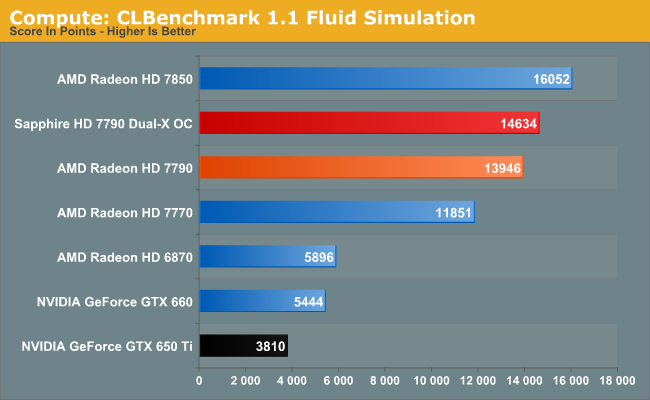
Moving on, our 4th compute benchmark is FAHBench, the official Folding @ Home benchmark. Folding @ Home is the popular Stanford-backed research and distributed computing initiative that has work distributed to millions of volunteer computers over the internet, each of which is responsible for a tiny slice of a protein folding simulation. FAHBench can test both single precision and double precision floating point performance, with single precision being the most useful metric for most consumer cards due to their low double precision performance. Each precision has two modes, explicit and implicit, the difference being whether water atoms are included in the simulation, which adds quite a bit of work and overhead. This is another OpenCL test, as Folding @ Home is moving exclusively OpenCL this year with FAHCore 17.
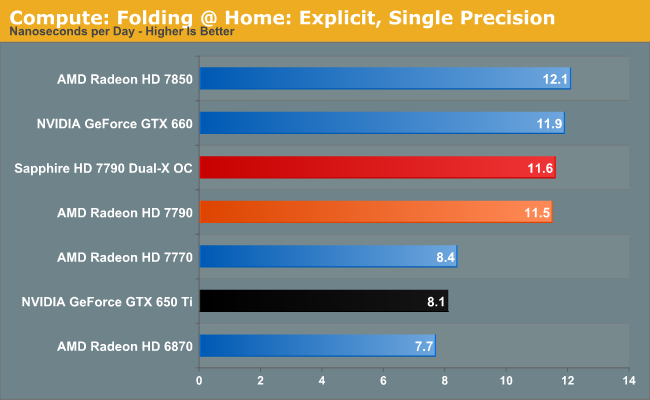
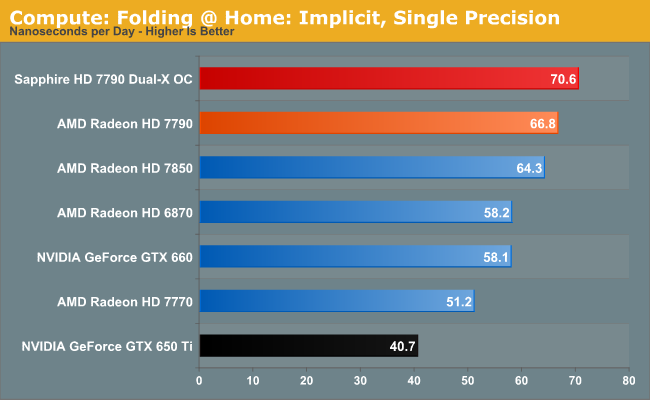
Our 5th compute benchmark is Sony Vegas Pro 12, an OpenGL and OpenCL video editing and authoring package. Vegas can use GPUs in a few different ways, the primary uses being to accelerate the video effects and compositing process itself, and in the video encoding step. With video encoding being increasingly offloaded to dedicated DSPs these days we’re focusing on the editing and compositing process, rendering to a low CPU overhead format (XDCAM EX). This specific test comes from Sony, and measures how long it takes to render a video.
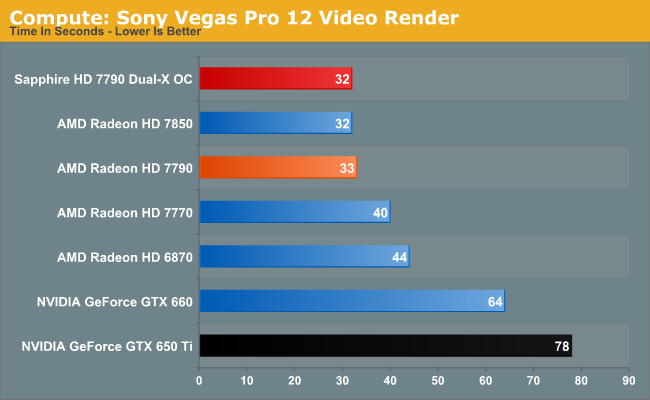
Wrapping things up, our final compute benchmark is an in-house project developed by our very own Dr. Ian Cutress. SystemCompute is our first C++ AMP benchmark, utilizing Microsoft’s simple C++ extensions to allow the easy use of GPU computing in C++ programs. SystemCompute in turn is a collection of benchmarks for several different fundamental compute algorithms, as described in this previous article, with the final score represented in points. DirectCompute is the compute backend for C++ AMP on Windows, so this forms our other DirectCompute test.
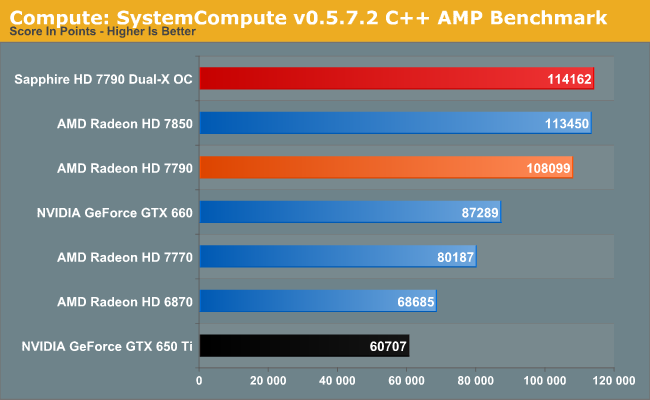


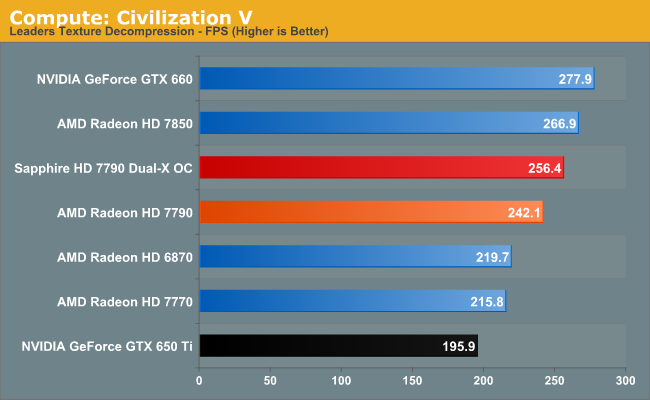








107 Comments
View All Comments
ThomasS31 - Friday, March 22, 2013 - link
I dont think this is the Sea Island generation yet...Ryan Smith - Friday, March 22, 2013 - link
This is Sea Islands. Oland and Bonaire are both part of the Sea Island family.CeriseCogburn - Sunday, March 24, 2013 - link
Bonaire sounds (like Bel Air) all stuffy and prim and proper - too bad amd fanboys aren't classy.At least it's not pitcairn, the in the pit card.
KnightRAF - Monday, March 25, 2013 - link
Congratulations Cerise, between this article and the HTC One article you have succeeded in injecting so much pointless crap that it is no longer worth the effort to sift your crap out to read the actual comments on the article.extide - Friday, March 22, 2013 - link
PLEASE!!! Add folding@home benchmarks to your tests, please please!!Thank You!
JarredWalton - Friday, March 22, 2013 - link
Might want to read a little better before posting:http://www.anandtech.com/show/6837/14
extide - Tuesday, March 26, 2013 - link
Sorry, doh, I feel dumb. I quickly scanned the compute page and didn't see it. Thank you VERY MUCH for including these!!MrSpadge - Friday, March 22, 2013 - link
It's good to see clock & voltage states become more fine-grained and their choice smarter. Ultimately how I'd like a GPU to work: set targets and limits for power use, temperature and noise.. and then crank it up as far as it goes. Vary chips by different amounts of execution units, not frequencies.This includes simple user settings for lowering power consumption (call it the "green mode" of whatever), if people want to, which would automatically choose lower voltages to increase efficiency.
And of course something similar to nVidias frame rate target: if performance if fine now, save power. And save some thermal headroom in case it's needed soon. Make smart use of the power budget. It's nice to see AMD making some progress!
Termie - Friday, March 22, 2013 - link
Ryan, just FYI, you're using Catalyst 13.2 beta 7 with the other cards, not Catalyst 13.7 betas as indicated in the text on "The Test" page.Ryan Smith - Friday, March 22, 2013 - link
Whoops. Thanks.